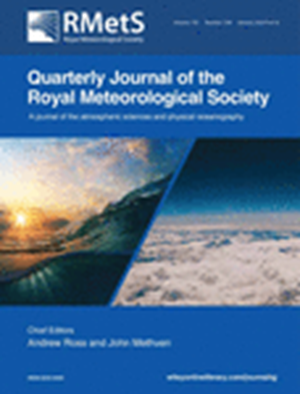影响欧亚大陆北部寒流亚季节可预测性的因素
IF 2.9
3区 地球科学
Q2 METEOROLOGY & ATMOSPHERIC SCIENCES
引用次数: 0
摘要
冷空气爆发会对人类健康、能源消耗、农业和整体福祉产生重大影响。本研究旨在评估亚季节到季节(S2S)模式在预测欧亚大陆北部寒冷条件方面的有效性,这里的寒冷条件是指每周平均 2 米气温异常的下三次方。为了评估这些事件的可预测性,我们使用了 S2S 数据库中五个预测系统的集合后报。我们的分析重点是确定在哪些条件下,模式有信心以很高的概率(0.5)预测未来 3-4 周的低温,这些条件有可能代表预报机会窗口。我们将正确预测事件的预测组与预测实际未发生事件(误报)的预测组进行了比较。大多数有把握的寒流预报,无论是正确预报还是误报,其初始条件都已经出现了寒冷异常,通常与北大西洋涛动的负相或斯堪的纳维亚阻塞同时出现。我们发现,S2S 模式倾向于过高预测低温,当预测在弱极地涡旋期间初始化时,更容易出现误报。此外,大多数有把握的误报都是从平流层而不是对流层内部动力学接收信号。当极地涡旋处于恢复阶段时,在弱极地涡旋条件下初始化的误报更为常见,随后,向下传播的信号在对流层中的持续时间很短。对不同马登-朱利安涛动(MJO)阶段的预报分析表明,近一半有把握的正确低温预报是在第 6-8 阶段活跃的 MJO 期间初始化的。另一方面,大多数误报发生在第 3 阶段,我们认为这是因为该阶段的初始条件中存在斯堪的纳维亚阻塞机制。本文章由计算机程序翻译,如有差异,请以英文原文为准。
Factors influencing subseasonal predictability of northern Eurasian cold spells
Cold‐air outbreaks have significant impacts on human health, energy consumption, agriculture, and overall well‐being. This study aims to evaluate the effectiveness of Subseasonal‐to‐Seasonal (S2S) models in predicting cold conditions over northern Eurasia, defined here as the lower tercile of weekly mean 2‐metre temperature anomalies. To assess the predictability of these events we use ensemble hindcasts from five prediction systems from the S2S database. Our analysis focuses on identifying the conditions under which the models confidently predict cold temperatures with a high (>0.5) probability 3–4 weeks ahead, which potentially can represent windows of forecast opportunity. We compare the group of forecasts that correctly predicted the events to the group that forecasted events that did not occur in practice (false alarms). Most of the confident forecasts of cold spells, both correct and false alarms, have cold anomalies already in the initial conditions, often in conjunction with either a negative phase of the North Atlantic Oscillation, or Scandinavian Blocking. We find that S2S models tend to overpredict cold temperatures, with false alarms occurring more likely when the forecasts are initialized during a weak polar vortex. Furthermore, most of the confident false alarms receive the signal from the stratosphere rather than following internal tropospheric dynamics. False alarms initialized during the weak polar vortex conditions are more common when the vortex is in a recovery stage and, subsequently, the downward ‐propagating signal is short‐lived in the troposphere. The analysis of forecasts during different Madden–Julian Oscillation (MJO) phases shows that nearly half of all confident correct cold‐temperature forecasts are initialized during an active MJO in phases 6–8. On the other hand, most false alarms occur during phase 3, which we suggest is due to the presence of the Scandinavian Blocking regime in the initial conditions for this phase.
求助全文
通过发布文献求助,成功后即可免费获取论文全文。
去求助
来源期刊
CiteScore
16.80
自引率
4.50%
发文量
163
审稿时长
3-8 weeks
期刊介绍:
The Quarterly Journal of the Royal Meteorological Society is a journal published by the Royal Meteorological Society. It aims to communicate and document new research in the atmospheric sciences and related fields. The journal is considered one of the leading publications in meteorology worldwide. It accepts articles, comprehensive review articles, and comments on published papers. It is published eight times a year, with additional special issues.
The Quarterly Journal has a wide readership of scientists in the atmospheric and related fields. It is indexed and abstracted in various databases, including Advanced Polymers Abstracts, Agricultural Engineering Abstracts, CAB Abstracts, CABDirect, COMPENDEX, CSA Civil Engineering Abstracts, Earthquake Engineering Abstracts, Engineered Materials Abstracts, Science Citation Index, SCOPUS, Web of Science, and more.

 求助内容:
求助内容: 应助结果提醒方式:
应助结果提醒方式:


